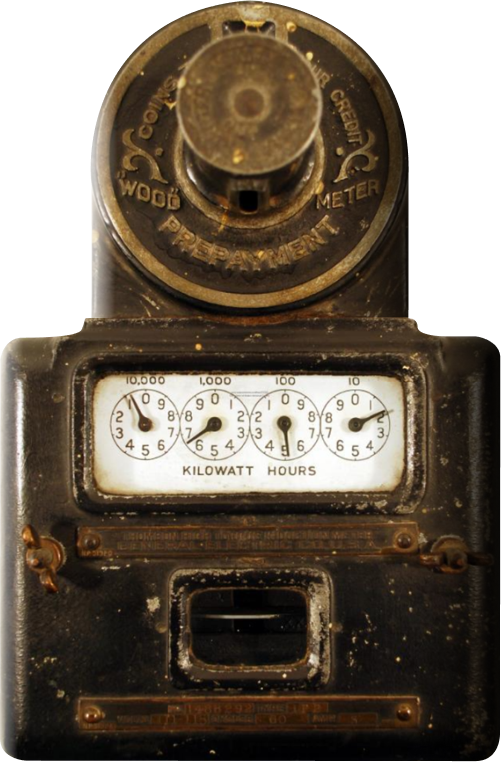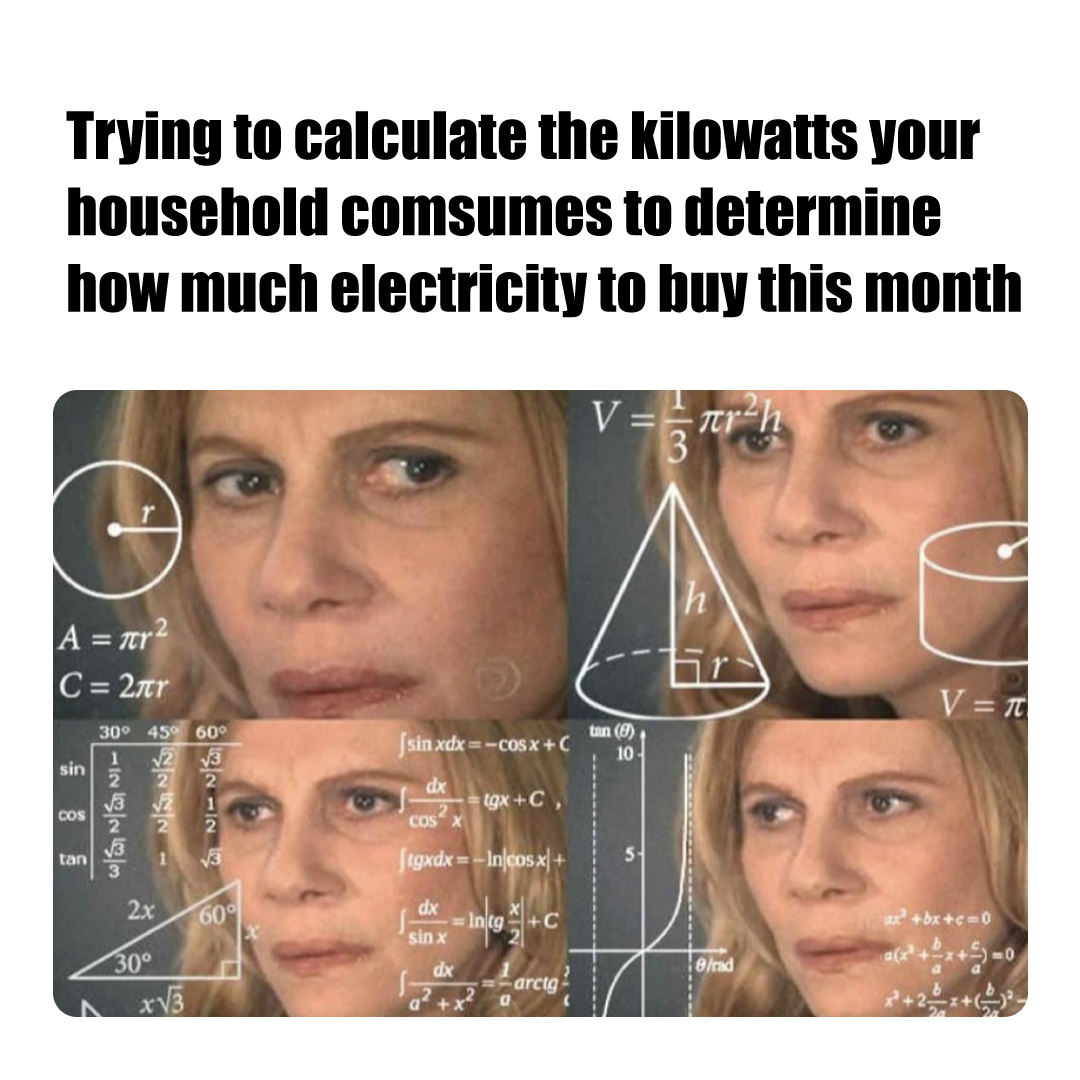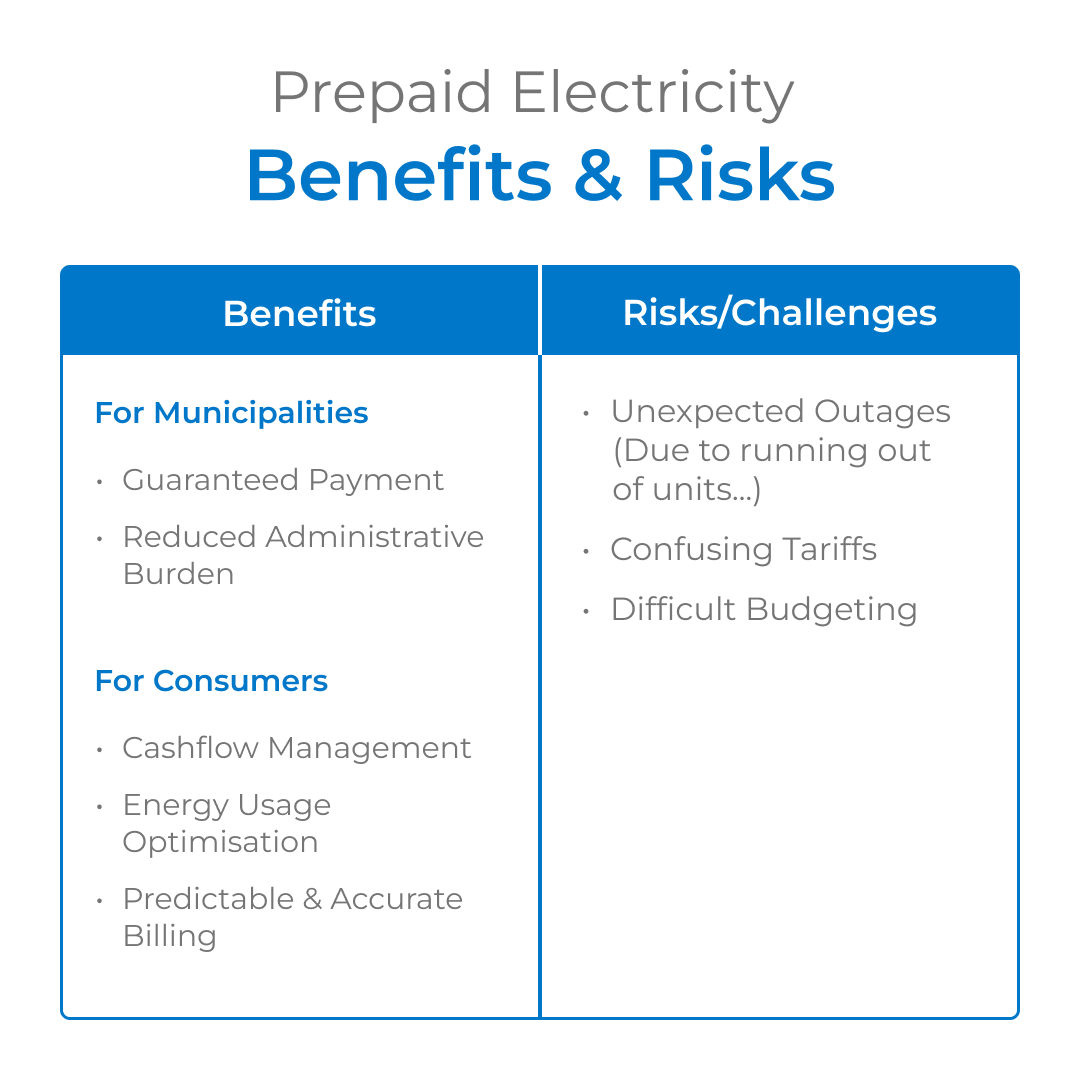Why does South Africa have prepaid electricity? Benefits & Risks
Corné Lindeque - 13 September 2024
For most South Africans, having a prepaid electricity meter in their house or apartment is pretty standard. But that wasn’t always the case. In fact, until 1990, there weren’t any prepaid meters in the country.
Millions of us have gone through the following process hundreds of times: Buy an electricity token online or in a physical store, punch it into our meter and watch the kWh balance update. It’s become an unavoidable part of countless household’s weekly or monthly routines.
Unfortunately, most of us also know what it feels like to run out of electricity – a uniquely “prepaid” feature…
Prepaid24 has been on the South African prepaid journey for almost 15 years. As one of the first companies in the country to sell prepaid electricity online – even before the banks did so – we helped pioneer the industry and have watched it take off to where it is today.
Why do we have prepaid electricity?
Why does South Africa have one of the highest prepaid meter rollout percentages worldwide?
What are some of the risks and benefits of a prepaid electricity system?
Is there anything consumers can do to overcome the challenges of a prepaid system?
We’ve done some research and drawn from our years of experience to answer these questions. In this article, we want to give you a quick rundown of prepaid electricity meters’ origin, share some fun facts and insights, and explain what some of the benefits and risks of a prepaid electricity system are (with some helpful tips to mitigate these risks).
Prepaid Electricity: A Brief History
The very first prepaid electricity meter was produced by General Electric in the United Kingdom all the way back in 1899 – only 11 years after the Thomas Edison installed the USA’s first private electricity system in his own home. (Which means that people were running out of prepaid electricity even before World War I started. See, we really aren’t dealing with as many “new” problems as we think.)
This first rendition of the prepaid meter was known as a “coin-in-slot” meter, with customers needing to insert coins into the meter to pay for their electricity. You can almost imagine it as a payphone-style electricity vending machine!
Below is a photo of a General Electric coin-operated prepaid electricity meter from 1907:

As one can imagine, these meters were not particularly reliable and were also subject to the theft of coins, which led to their rather quick replacement with newer models.
FUN FACT:
The first prepaid electricity meter was produced in 1899 and was COIN OPERATED!
Fast-forward a “quick” 100 years to 1997, and the STS (Standard Transfer Specification) Association is formed to standardise communication protocols for prepaid meters across the world. This was initiated by Eskom, South Africa’s main power utility, who helped develop the 20-digit token numbers which we purchase and punch into our meters today.
Far from that historic coin-operated prepaid meter of 1899, some today have smart prepaid meters in their homes which are able to accommodate multiple tariff structures based on what season it is and accept tokens remotely without someone having to manually punch the numbers in.
However, the principle behind these modern smart meters and that very first 1899 prototype is exactly the same: You pay BEFORE you use.

As one can imagine, these meters were not particularly reliable and were also subject to the theft of coins, which led to their rather quick replacement with newer models.
FUN FACT:
The first prepaid electricity meter was produced in 1899 and was COIN OPERATED!
Fast-forward a “quick” 100 years to 1997, and the STS (Standard Transfer Specification) Association is formed to standardise communication protocols for prepaid meters across the world. This was initiated by Eskom, South Africa’s main power utility, who helped develop the 20-digit token numbers which we purchase and punch into our meters today.
Far from that historic coin-operated prepaid meter of 1899, some today have smart prepaid meters in their homes which are able to accommodate multiple tariff structures based on what season it is and accept tokens remotely without someone having to manually punch the numbers in.
However, the principle behind these modern smart meters and that very first 1899 prototype is exactly the same: You pay BEFORE you use.

As one can imagine, these meters were not particularly reliable and were also subject to the theft of coins, which led to their rather quick replacement with newer models.
FUN FACT:
The first prepaid electricity meter was produced in 1899 and was COIN OPERATED!
Fast-forward a “quick” 100 years to 1997, and the STS (Standard Transfer Specification) Association is formed to standardise communication protocols for prepaid meters across the world. This was initiated by Eskom, South Africa’s main power utility, who helped develop the 20-digit token numbers which we purchase and punch into our meters today.
Far from that historic coin-operated prepaid meter of 1899, some today have smart prepaid meters in their homes which are able to accommodate multiple tariff structures based on what season it is and accept tokens remotely without someone having to manually punch the numbers in.
However, the principle behind these modern smart meters and that very first 1899 prototype is exactly the same: You pay BEFORE you use.

As one can imagine, these meters were not particularly reliable and were also subject to the theft of coins, which led to their rather quick replacement with newer models.
FUN FACT:
The first prepaid electricity meter was produced in 1899 and was COIN OPERATED!
Fast-forward a “quick” 100 years to 1997, and the STS (Standard Transfer Specification) Association is formed to standardise communication protocols for prepaid meters across the world. This was initiated by Eskom, South Africa’s main power utility, who helped develop the 20-digit token numbers which we purchase and punch into our meters today.
Far from that historic coin-operated prepaid meter of 1899, some today have smart prepaid meters in their homes which are able to accommodate multiple tariff structures based on what season it is and accept tokens remotely without someone having to manually punch the numbers in.
However, the principle behind these modern smart meters and that very first 1899 prototype is exactly the same: You pay BEFORE you use.

As one can imagine, these meters were not particularly reliable and were also subject to the theft of coins, which led to their rather quick replacement with newer models.
FUN FACT:
The first prepaid electricity meter was produced in 1899 and was COIN OPERATED!
Fast-forward a “quick” 100 years to 1997, and the STS (Standard Transfer Specification) Association is formed to standardise communication protocols for prepaid meters across the world. This was initiated by Eskom, South Africa’s main power utility, who helped develop the 20-digit token numbers which we purchase and punch into our meters today.
Far from that historic coin-operated prepaid meter of 1899, some today have smart prepaid meters in their homes which are able to accommodate multiple tariff structures based on what season it is and accept tokens remotely without someone having to manually punch the numbers in.
However, the principle behind these modern smart meters and that very first 1899 prototype is exactly the same: You pay BEFORE you use.
The Benefits of Prepaid Electricity
Prepaid electricity meters were introduced for a variety of reasons, and a prepaid electricity system offers several benefits to both consumers and municipalities alike.
For Municipalities…
First, let’s start with the benefits for municipalities:
1. Guaranteed Payment
Having customers pay for their electricity before using it eliminates the risk of non-payment for municipalities. With a prepaid system, municipalities can rest in the fact that every unit consumed has already been paid for, helping them to ensure payment to their suppliers.
Though non-payment isn’t as much of a problem in the USA or Europe, it is unfortunately a very common issue in developing countries like South Africa, which is why prepaid meters have become the norm in our country.
2. Reduced Administrative Burden
A prepaid electricity system also removes a massive administrative burden from municipalities, as they no longer need to send out field teams to manually read meters (often guarded by dogs or inaccessible due to customers not being at home). With a prepaid system, municipalities also don’t have to send out monthly electricity bills, as slips are provided to customers at the time of purchase.
For Consumers…
Residents also benefit from a prepaid electricity system in the following ways:
1. Cashflow Management
By buying their electricity with smaller, more regular payments, consumers are able to better manage their monthly cashflow and expenditure.
Instead of receiving large, unpayable bills at the end of the month, a prepaid electricity system ensures that residents only end up using what they can afford. Thus, indiscriminate or oblivious usage and preventable debt are avoided. This is especially valuable for low-income households.
2. Energy Usage Optimisation
By seeing how the units on their prepaid meter decrease during certain times of the day, residents are able to see which activities and/or appliances use the most energy. This enables households to optimise their consumption by minimising non-essential electricity usage. This would not have been possible if you just got a summarised electricity bill at the end of the month.
3. Predictable & Accurate Billing
Perhaps the most important benefit of having a prepaid electricity meter in your home is the fact that you cannot get inaccurate (and often ridiculous) energy bills from your municipality.
With questionable consumption “estimates” and administrative shortcomings in many South African municipalities, one regularly hears of people who receive electricity bills that exceed their normal electricity usage by 10 or 20 times! This often leads to drawn-out legal disputes and a lot of stress which could have been avoided.
The Risks of Prepaid Electricity
But, as we all know, prepaid electricity does have its shortcomings. Here are a few:
1. Unexpected Outages
As mentioned earlier in this article, there is a major downside to prepaid electricity – the risk of running out of units.
We’ve all experienced it before: You’re busy cooking dinner or watching your favourite TV show when the lights suddenly go out. You assume it’s a neighbourhood-wide power outage or an unexpected round of loadshedding, only to later realise that your prepaid electricity meter actually just ran out of credit.
This certainly isn’t an enjoyable experience and can cause great frustration and inconvenience.
2. Confusing Tariffs
The other risk (or rather, challenge) of a prepaid electricity system is its confusing tariffs. Because most prepaid meters in South Africa are not smart (yet) and don’t accommodate time-of-use tariffs, South African municipalities opted to go with block/step tariffs for prepaid electricity users.
Block tariffs were introduced to incentivise residents to consume less electricity, resulting from Eskom’s generation challenges and the fact that it penalises municipalities for putting too much strain on its capacity and delivery. Thus, the reasoning behind block tariffs makes sense. But that doesn’t make them any easier to understand. In fact, for most people, they’re downright confusing.

People don’t know when the cheapest time to buy electricity is (if that even exists), nor do they know what the optimal purchase amount is to ensure they don’t get overcharged for their units. Most people just buy electricity and wait to see how many units they get.
With all the mystery, myths and urban around surrounding prepaid block tariffs and how they actually work, simplification and education are certainly needed on this front.
3. Difficult Budgeting
How much did your household spend on prepaid electricity last month? What about the same month last year?
If you don’t exactly know the answers to these questions, don’t worry. You’re not alone.
Because prepaid electricity purchases are often made on a buy-as-you-need basis, it’s not easy to keep track of monthly spend. This is made even tougher in households where there is more than one person responsible for electricity top-ups, because purchases are usually made from different accounts and on different profiles.
Thus, due to the varying nature of prepaid top-ups and the fact that you don’t get a summarised monthly bill at the end of the month like with a post-paid system, setting up an accurate budget for prepaid electricity is very challenging. And with financial times being the way they are, this is a problem that needs to be addressed.
Here is a table summarising the benefits and risks of a prepaid electricity system:

How We Help Mitigate Prepaid Electricity’s Risks
It’s one thing to understand that prepaid electricity comes with certain risks, but is it possible for us to mitigate these risks?
Are there measures that South Africans can implement to reduce their chances of being caught out by the challenges that come with a prepaid electricity system?
We at Prepaid24 are delighted to answer these questions with a resounding YES!
Risk 1: Forgetting to Buy Electricity
Solution: WhatsApp Purchase Reminders + Scheduled Purchases
If each of us got R10 for every time we’ve forgotten to buy electricity, we’d probably all have bought that pair of shoes sitting at the top of our “Wants” list already.
The reality is that there are always more important things to keep track of than topping up your prepaid electricity units. You know, like picking up the kids from school on time or planning the next family getaway.
We understand this, which is why we developed our WhatsApp Purchase Reminders and Scheduled Purchases benefits to remove some stress from your shoulders.
Imagine receiving a timely WhatsApp message reminding you to top up electricity on a day of your choice. Or receiving your tokens AUTOMATICALLY every month, without the need for you to lift a finger. Well, it can be!
Kindly reach out to us on Prepaid24 Support. We will gladly help you to set up personalised WhatsApp reminders or (even better) assist you with setting up scheduled EFT payments to well and truly put your monthly electricity top-ups on auto-pilot. This is how many of our clients choose to operate and really is the ultimate luxury.
Why not let Prepaid24, your dedicated online electricity partner, take over the burden of remembering your monthly purchases? We won’t let you down.
Risk 2: Tricky Step/Block Tariffs
Solution: Expert Purchase Evaluation & Planning
Questions around prepaid electricity tariffs are probably some of the most common queries our client support team receives on a daily basis. Our caring consultants have explained block tariffs to thousands of South Africans, and we’d love to simplify this subject for you too.
Feel free to contact us on Prepaid24 Support. One of our in-house electricity experts will gladly answer any questions you may have and can even do a personalised tariff calculation for you based on your municipality’s rates and your actual monthly spend.
You don’t have to be in the dark about what you’re paying and how many units you can expect to receive. We’re here to help.
*For a more comprehensive breakdown and explanation of municipal step tariffs, read our article “Electricity Block/Step Tariffs Explained”. In this article, we bust several of the major myths around step tariffs and also give you some real-life examples to better explain how they work.
Risk 3: The Difficulty of Budgeting
Solution: Prepaid24’s Monthly Electricity Breakdowns
As part of Prepaid24’s service, we send our clients a monthly electricity spend report for each of the meters on their profile.
These reports are sent out on the first business day of every month and include the previous month’s purchases, tokens and kWh units received. We also give you Year-on-Year Comparisons so that you can see what the actual impact of Eskom’s annual price increases is on your electricity spend, as well as a 12-Month Overview so that you can better understand the influence of things like changing seasons and school holidays on your electricity consumption.
To cater for households who have more than one person buying electricity on Prepaid24, we include all the purchases made for a specific meter number on its Monthly Electricity Breakdown and send it to every person who made a purchase for that meter in the previous month. This way, you will be able to view your household’s spend wholistically and will not need to manually add or consolidate purchases yourself.
At the end of the day, our goal is to make every South African’s prepaid electricity journey a smooth and value-filled one. Yes, a prepaid system certainly has many benefits and upsides, but it is not without its risks and challenges. Prepaid24 is here to make sure that our clients have all the support and solutions they need for stress-free prepaid electricity top-ups.
Allow us to Exceed your Expectations.
Quick Questions
- Did you find this article insightful or helpful?
- Do you think that one of your friends or family members can benefit from the information in this article?
If you do, please share this article through one of the options below. Every single share represents one more informed electricity consumer and is a valuable step in creating a more educated and better serviced South African electricity industry.
Share this article with friends & family!
Sources
Below are the sources used for this article:
(Feel free to give them a read for some more in-depth insight into the history, reasoning and technology behind prepaid electricity meters.)
- https://www.smart-energy.com/industry-sectors/smart-meters/prepayment-metering-what-will-the-future-bring/
- https://www.parkerandsons.com/blog/when-did-homes-first-get-electricity-a-historical-insight
- https://www.sts.org.za/what-is-the-sts-and-who-is-the-sts-association
- https://www.securemeters.com/eu/white_papers/prepayment-metering-system/



